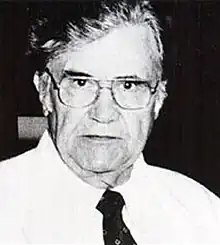Harry Bailey
Harry Richard Bailey (29 October 1922, Picton, New South Wales – 8 September 1985, Mount White, New South Wales) was an Australian psychiatrist and hospital administrator. He bore the primary responsibility for treatment of mental health patients and drug dependent clients via deep sleep therapy and other methods at a mental hospital in the Sydney North Shore suburb of Pennant Hills where he was its principal. The treatment has been linked with the deaths of a total of 85 patients, including 19 who committed suicide.[1] Bailey committed suicide while he was being investigated. One of Bailey's clients was Australian rock and pop singer and songwriter Stevie Wright, who was being treated for methadone addiction, a report that was later part of a 2013 documentary on Australian Story.[2]

Early life and training
Bailey was born in Picton, New South Wales, to Jack Nelson Bailey, a stationmaster and railway officer, and Ruth Kathleen Bailey née Smith. He attended Christian Brothers College, Waverley, then enrolled in science at the University of Sydney in 1940.[3] Unable to complete his studies at the time for financial reasons, he earned extra money by taking a position as a pharmacist's assistant. Then he went back to study medicine at Sydney University, graduating in medicine 1951 and in psychiatry in 1954. He was awarded the Norton Manning memorial prize for psychiatry and the Major Ian Vickery prize for paediatrics.[3]
From December 1954, he spent fifteen months on a World Health Organization fellowship in North America and Europe, where he observed the sedation techniques, psychosurgery, and electroconvulsive therapy methods of Ewan Cameron in Canada, William Sargant in the UK, and Lars Leksell in Sweden.[3]
Whereas most of his compatriots who specialized in psychiatry sought out their advanced further training in Britain, Bailey worked in Louisiana with Robert Heath of Tulane University. He also studied electroconvulsive therapy and surgical and pharmacological care under Sir William Trethowan and Cedric Howell Swanton back in Australia. Bailey had shunned psychoanalysis – also known as "the talking cure" – as a treatment for psychiatric problems, and instead chose to focus on what he deemed to be more conventionally practical and pragmatic treatments like drug therapy and "psychosurgery".[4]
Deep sleep therapy
In 1952, Bailey was assistant director of clinical psychiatry for the public health service. Between 1962 and 1979, he served as chief psychiatrist at Chelmsford Private Hospital, Pennant Hills, northwest of Sydney. Under his care, 26 patients died.[5] The last of the deaths occurred in the early hours of 12 August 1977.[6]
DST was Bailey's invention, a cocktail of barbiturates to put patients into a coma lasting up to 39 days, while also administering electro-convulsive therapy (ECT). Bailey likened the treatment to switching off a television; his self-developed theory was that the brain, by shutting down for an extended period, would "unlearn" habits that led to depression, addiction and other psychiatric conditions. Bailey claimed to have learnt DST from psychiatrists in Britain and Europe, though it was later found that only a mild variant was used there, sedating traumatised ex-soldiers for a few hours at a time, not the median 14 days under which Bailey and his colleague Dr John Herron subjected their 1,127 DST patients at Chelmsford between 1963 and 1979.[6]
Chelmsford investigation
The resultant scandal broke in the early 1980s, following two 60 Minutes programs in 1980 and 1982, and Chelmsford was closed down entirely. In 1985, the "legal and medical investigative machinery finally co-ordinated their actions and Bailey was facing committal proceedings over the death of Miriam Podio in 1977".[6]
The Chelmsford Royal Commission, under the Greiner government, from 1988 to 1990, headed by Justice John Slattery of the New South Wales Supreme Court, produced findings concerning Chelmsford's treatment program that ran to twelve volumes and included deplorable conditions, fraud and misconduct and medical negligence.
Death
Bailey died by suicide, ingesting barbiturates at Mount White. He left a suicide note: "Let it be known that the Scientologists and the forces of madness have won".[7] The Citizens Commission on Human Rights, a front group of the Church of Scientology, had been active in publicising the scandal. The government then banned the treatment and instigated stricter guidelines governing the administration and the care of mental patients.
References
- Kaplan, Robert M. (June 1, 2009). Medical Murder: Disturbing cases of doctors who kill. Allen & Unwin. ISBN 9781741765779 – via Google Books.
- Rachel Browne. "The addiction that took everything from Stevie Wright". Sydney Morning Herald.
- Australian Dictionary of Biography, Australian National University, Canberra http://adb.anu.edu.au/biography/bailey-harry-richard-12162
- "Dark Trance". Susan Geason.com. Retrieved 26 December 2017.
- When power came before patients. Sydney Morning Herald 11 October 1991.
- Malcolm Knox (April 13, 2013). "The big sleep". The Age.
- Chandler, Jo; MacDonald, Jacqui (22 April 1991). "The battle to control the mind". The Melbourne Age. Retrieved 23 April 2012.
- The New South Wales Royal Commission into Chelmsford Private Hospital: Available in reference form at the N.S.W. State Library.
- Bromberger, Brian, and Fife-Yeomans, Janet, Deep Sleep: Harry Bailey and the Scandal of Chelmsford, Simon & Schuster Australia (East Roseville, New South Wales), 1991.
- Franklin, James, Corrupting the Youth: A History of Philosophy in Australia, Macleay Press, Sydney, 2003, ch. 9
- Jones, D. Gareth. (March 1990) "Contemporary Medical Scandals: A Challenge to Ethical Codes and Ethical Principles." Perspectives on Science and Christian Faith. No. 42, pp. 2–14